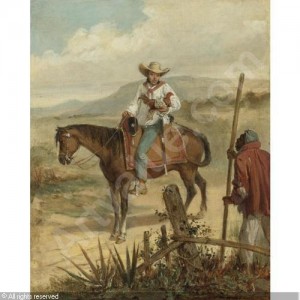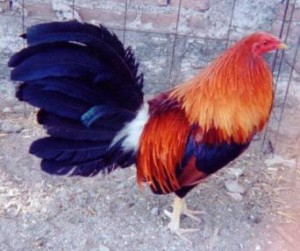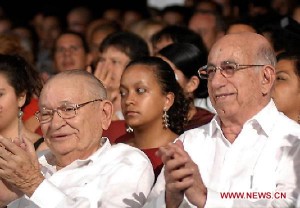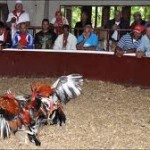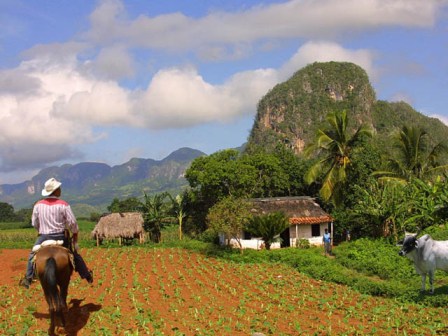In Cuba, a country man on horseback (guajiro), wearing guayabera and hippie hat, a guitar slung over his shoulder and a fine cock in hand, always became a symbol of Cuban identity.
Remarkable slenderness, average height, elongated head, toothed crest, and reinforced double peak, piercing eyes, slightly arched neck, long wings tight to the body, sometimes crossing back, tail long and flowing, extended walking, strong legs with spurs pronounced natural, dark reddish plumage (Indian). This type of cock and no other, is the most similar by their nature outside our cocks Creoles.
The cock is an animal essentially insensitive and very primitive, its temperature is above 40 degrees Celsius, which minimizes their ability to experience pain, much higher than that of men and therefore less well tolerated wounds, say that much better humans. They are aggressive by nature, they fight each other in the wild, and even in domestic conditions, that is their reason for being and man, far from exploiting the situation, all it does is to channel that instinct to balance and humanize through a variety measures and regulations, which will inevitably happen, imperative of nature, in one or another place.
Origin
Since ancient times, certain data are the fans of man by the cockfighting. Were the Chinese, in Asia, the first to practice this sport, two thousand years before our era.
In Cuba the Gamecocks came around 1826, a date has not been accurately established, becoming the practice of this sport in what might be defined as the primary means of recreation and relaxation of the Cubans at the time, especially the peasant population, who welcomed him with interest and enthusiasm overflowing.
Cockfights were fine, a little later outlawed and persecuted by the authorities stubbornly cockers the Spanish colonial government, who chose tolerance, convinced that they could not break the will of the natives willing to move forward. This situation continued until the advent of free and independent republic that acknowledged cockfights and were officially approved.
As a historical curiosity emphasize that the cry of Freedom and Independence came in a fence of roosters, February 24, 1895 in the city of Bayamo, in the east, by a group of Cuban patriots who gave thus start War of independence of Cuba, which ended Spanish colonial rule.
With the republic, lovers of the pastime were organized and formed partnerships with individual contributions, built clubs for sport in the provincial capitals and other major cities.
In Cuba, celebrated every year the national holiday of chicken, which began with the nation’s capital and then spread to the provinces. Prizes were awarded for speed, or swoop in to combatants rivals in the shortest time unit. In this competition galardonaban the three copies, by order, achieved the best times.
In 1947 he was called the First National Contest of breeders, which was held at the Cockfighting Club in Havana, located in the area of Vedado. The roots of cockfights in the Caribbean island, is of such magnitude that it may well be considered one of the noblest and acendradas traditions of the Cuban people.
The Creoles, with his characteristic wit and audacity, they created a Cuban school breeding, care and general preparation of fighting cocks, which later spread to several countries in Central and South America, including Mexico, Costa Rica and Venezuela .
The Cuban family of fighting cocks, lived a golden period in the middle of last century, when they met in time, breeders of the prestige and stature of Jorge Luis Abreu masterful in Las Villas, and Dr. Jorge Romañach, Diego Trinidad Velasco, Colonel Mendieta and Zayas brothers, owners of Linner Laboratories in Havana.
In Pinar del Rio stood Daniel Maria Rodriguez, Gustavo Sanchez, Joseph A. Abreu (Cunia), rattle Sierra, Dr. Alejandro Mora, and Justico Iturrey Bartolo Garcia, plus Antonio (Nico) Vera and Antonio Ma Padron, among others.
Current Cuban
http://www.youtube.com/watch?v=RWaZbdEcoDQ
In Havana, is currently the largest breeder of fighting cocks Cuba. Creole-At Finca Alcona, a few miles south of Havana, is currently the largest breeder of fighting cocks Creoles of Cuba. There are prepared, trained, selected, and are met (cast to fight as a test) before being exported. On the farm there is a fence and held each year Gallo Fair, bringing together farmers covered by the state.
Cuba is expanding its range of exports with exotic animals and species in danger of extinction to generate foreign exchange.
A company led by Commander of the Revolution Guillermo Garcia Frias dedicated to fighting cocks export, Cuban crocodiles and other species of Caribbean flamingos, was selected as one of the best exporters of 2009 on the island. Alcona SA was awarded the National Exporter in the category of small businesses entering up to two million pesos in the hands of the Commander also Ramiro Valdes, vice president of the Council of State and Ministers.
Alcona House
La Finca Alcona, Managua is located in Arroyo Naranjo municipality, Havana City. This center belongs to the Flora and Fauna company dedicated to the export of roosters. It has a theater where they perform competitions, fairs and international roosters, has Creole food restaurants, barbecue and cafeteria. The cockers and breeders involved in the seasons of roosters are duly accredited and registered by completing the competitive rules created by this institution. According to a Cuban edition of the magazine group Excellencies, Alcona annually sells about 700 fighting cocks, species often confiscated in Cuba during raids on underground Vallas.
According to the National Bureau of Statistics, in 2009 Cuba exported live animals worth 79 million 981 thousand pesos, a figure far below the 459 million 899 thousand pesos admitted that concept in 2004.
The traditional cockfighting were banned by the government of Fidel Castro in 1968.
In 1972, with the support of Celia Sanchez, secretary of the Council of State Fidel Castro’s personal assistant-Garcia Frias government established the first breeding of fighting cocks. In the mid 80’s the government decriminalized the fights, setting strict regulations that allow company controlled by fences and Wildlife and also prohibit gambling linked to this tradition. The cockers tend to be fined between 1,500 and 3,000 pesos if the authorities are caught in fences independent, with or without betting. Only the current Cuban government monopolizes the popular industry.
Sources: Wiki/CafeFuerte/Varona/InternetPhoto/YouTube/TheCubanHistory.com
COCKFIGHTING in Cuba. History
The Cuban History, Arnoldo Varona, Editor
LAS PELEAS DE GALLOS en Cuba
En Cuba, un hombre de campo montado en su caballo, vistiendo guayabera y sombrero de jipi, una guitarra colgada del hombro y un gallo fino en la mano, se convirtió en símbolo de cubanía.
De esbeltez notable, regular estatura, cabeza alargada, cresta dentada, pico doble y reforzado, mirada penetrante, cuello ligeramente arqueado, alas largas apretadas al cuerpo, cruzándose a veces atrás, cola larga y abundante, al caminar extendida, patas fuertes, con espolones naturales pronunciados, color del plumaje rojizo oscuro (indio). Este tipo de gallo y no otro, es el más parecido por sus características exteriores a nuestros gallos criollos.
El gallo es un animal esencialmente poco sensible y muy primitivo, su temperatura es superior a los 40 grados centígrados, lo que minimiza su capacidad para experimentar dolor, muy superior a la del hombre y por ello tolera tan bien las heridas, digamos que mucho mejor que los humanos. Son agresivos por naturaleza, pelean entre sí en estado salvaje, y aún en condiciones domésticas, esa es su razón de ser y el hombre, lejos de explotar su situación, lo único que hace es canalizar ese instinto para equilibrarlo y humanizar mediante toda una serie de medidas y reglamentos, lo que inevitablemente habrá de suceder, por imperativo de la naturaleza, en uno o en otro lugar.
Origen
Desde épocas remotas, existen datos ciertos de la afición del hombre por las peleas de gallos. Fueron los chinos, en el continente asiático, los primeros en practicar este deporte, dos mil años antes de nuestra era.
A Cuba llegaron los gallos de pelea alrededor de 1826, fecha que no ha podido ser exactamente establecida, convirtiéndose la práctica de este deporte en lo que pudiera definirse como el principal medio de recreación y esparcimiento de los cubanos de la época, sobre todo de la población campesina, que lo acogió con interés y entusiasmo desbordantes.
Las peleas de gallos finos fueron, un poco más tarde, declaradas ilegales y perseguidos los galleros tenazmente por las autoridades del gobierno colonial español, que optaron por la tolerancia, convencidos de que no podrían doblegar la voluntad de los criollos dispuestos a seguir adelante. Esta situación se mantuvo hasta el advenimiento de la república libre e independiente que reconoció las lidias de gallos y fueron autorizadas oficialmente.
Como curiosidad histórica subrayamos que el grito de Libertad e Independencia se dio en una valla de gallos, el 24 de febrero de 1895 en la ciudad de Bayamo, en el oriente del país, por un grupo de patriotas cubanos que de esta forma daban inicio a la segunda guerra de independencia de Cuba, que terminó con el dominio colonial español.
Con la república, los amantes de ese pasatiempo se organizaron y constituyeron asociaciones que mediante aportes individuales, construyeron clubes para la práctica del deporte en las capitales de provincias y otras ciudades importantes del país.
En Cuba se celebraba todos los años la fiesta nacional del pollo, que comenzaba por la capital del país y luego se extendía a las provincias. Los premios se adjudicaban por rapidez, o sea, a los combatientes que abatieran a sus rivales en la más breve unidad de tiempo. En esta competencia se galardonaban a los tres ejemplares, que por orden, lograran los mejores tiempos.
En 1947 fue convocado el primer concurso Nacional de criadores, el cual se realizó en el Club Gallístico de La Habana, situado en la zona de El Vedado. La raigambre de las lidias de gallos en la Isla Antillana, es de tal magnitud, que muy bien pudiera considerarse como una de las más nobles y acendradas tradiciones del pueblo cubano.
Los criollos, con su ingenio y audacia característicos, crearon una escuela cubana de cría, cuidados y preparación general de los gallos de lidia, la que más tarde se extendió a varios países de centro y sur América, tales como México, Costa Rica y Venezuela.
La familia cubana de los gallos de pelea, vivió una etapa dorada a mediados del pasado siglo XX, cuando coincidieron en el tiempo, criadores del prestigio y la talla magistral de Jorge Luis Abreu, en Las Villas, así como el doctor Jorge Romañach, Diego Trinidad Velasco, el coronel Mendieta y los hermanos Zayas, dueños de los Laboratorios Linner, en La Habana.
En Pinar del Río sobresalieron Daniel María Rodríguez, Gustavo Sánchez, José A. Abreu (Cunia), Chinchín Sierra, el doctor Alejandro Mora, Bartolo Iturrey y Justico García; además de Antonio (Ñico) Vera y Antonio Ma. Padrón, entre otros.
Actualidad Cubana
http://www.youtube.com/watch?v=RWaZbdEcoDQ
En la Habana, se encuentra actualmente el mayor criadero de gallos de lidia criollos de Cuba.-En la Finca Alcona, a unos pocos kilómetros al sur de La Habana, se encuentra actualmente el mayor criadero de gallos de lidia criollos de Cuba . Allí se preparan, se entrenan, seleccionan, y se topan (echan a pelear como ensayo), antes de ser exportados. En la finca hay una valla y se realiza cada año la Feria del Gallo, que reúne a criadores amparados por el estado.
Cuba está ampliando su gama de exportaciones con animales exóticos y especies en peligros de extinción para generar divisas.
Una empresa dirigida por el comandante de la revolución Guillermo García Frías que se dedica a la exportación gallos de lidia, cocodrilos cubanos y flamencos caribeños entre otras especies, fue seleccionada como una de las mejores exportadoras del año 2009 en la isla. ALCONA SA recibió el Premio Nacional al Exportador en la categoría de empresas pequeñas que ingresan hasta dos millones de pesos de manos del también comandante Ramiro Valdés, vicepresidente del Consejo de Estado y de Ministros.
La Finca ALCONA
La Finca Alcona, se encuentra ubicada en Managua municipio Arroyo Naranjo, de Ciudad La Habana. Este centro perteneciente a la empresa de Flora y Fauna dedicada a la exportación de gallos finos. Cuenta con un coliseo donde se realizan competiciones, ferias de gallos nacionales e internacionales, posee restaurantes de comida criolla, parrilladas y cafetería. Los galleros y criadores que participan en las temporadas de gallos se encuentran debidamente acreditados e inscritos, cumplimentando el reglamento competitivo creado por esta institución. De acuerdo con una edición digital cubana del grupo de revistas Excelencias, ALCONA comercializa anualmente unos 700 gallos de pelea, especie a menudo confiscada en Cuba durante redadas contra las vallas clandestinas.
Según datos de la Oficina Nacional de Estadísticas, en el 2009 Cuba exportó animales vivos por un valor de 79 millones 981 mil pesos, una cifra muy por inferior a los 459 millones 899 mil pesos ingresados por ese concepto en el 2004.
Las tradicionales peleas de gallos fueron prohibidas por el gobierno de Fidel Castro en 1968.
En 1972, con apoyo de Celia Sánchez -secretaria del Consejo de Estado y asistente personal de Fidel Castro-, García Frías estableció el primer criadero estatal de gallos de pelea. A mediados de la década de los 80 el gobierno despenalizó las lidias, estableciendo estrictas regulaciones que permiten vallas controladas por Empresa de Flora y Fauna y a la vez prohíben las apuestas ligadas a esta tradición. Los galleros suelen ser multados con entre 1,500 y 3,000 pesos cubanos si las autoridades los sorprenden en vallas independientes, con apuestas o sin ellas. Solo el gobierno cubano actual monopoliza la popular industria nacional.
Sources: Wiki/CafeFuerte/Varona/InternetPhoto/YouTube/TheCubanHistory.com
COCKFIGHTING in Cuba. History
The Cuban History, Arnoldo Varona, Editor



 COCKFIGHTING in Cuba. History (Video) * PELEAS DE GALLOS en Cuba. Historia (Video).
COCKFIGHTING in Cuba. History (Video) * PELEAS DE GALLOS en Cuba. Historia (Video).